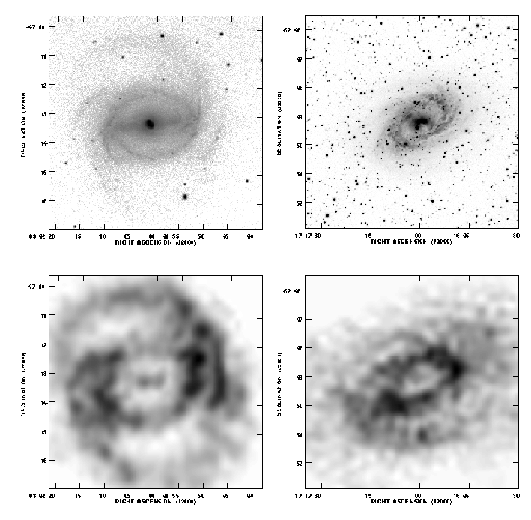Gas follows stars in resonance-ring galaxies
NGC 1433 and NGC 6300 are two of the best examples of the ringed barred galaxies. Previously inaccessible to aperture synthesis telescopes, they have now been studied in HI with the Australia Telescope Compact Array. The results have allowed us to determine, for both, the pattern speed of the bar: a parameter fundamental for simulations of galaxy dynamics but still poorly constrained.
About two thirds of disk galaxies are barred (SB) or weakly barred (SAB) systems. Many of these galaxies have one or more ring-like features in their stellar distributions. The rings fall into three main categories: nuclear rings, inner rings encircling the bar, and outer or pseudo-rings. All three types are thought to arise from the galaxy's internal dynamics (unlike the rarer polar rings and collisional rings). Each one is produced by a resonance between the speed at which the bar potential rotates and the period of small epicyclic (radial) oscillations of stars and gas clouds at that ring's radius. Thus, the location and dynamics of these resonance rings can be used to determine the pattern speed of the bar.
The southern spiral NGC 1433 is the prototypical ringed barred galaxy: it has all three of the main ring types. It has been well studied, yet its dynamics have not been completely analysed. NGC 6300 is almost identical in angular size and distance, but differs markedly in its features: it has no nuclear or outer pseudo-ring and its inner ring is exceptionally broad and dusty.
The optical and HI images of NGC 1433 and NGC 6300 are shown below. The stellar and gas rings are strikingly similar: the gas clearly feels the same resonant effects as the stars, accumulating near the rings and being swept out of other regions. Although predicted, this effect could not be confirmed before the advent of the AT Compact Array.
The bar pattern speed for both galaxies, derived by linear perturbation analysis, is 20-30 km s-1 kpc-1.
S. Ryder (UNSW); R. Buta (Uni. Alabama); L. Staveley-Smith, W. Walsh (ATNF)
Comparison of blue-light images (top, obtained with the CTIO 1.5-m telescope) with the surface density of neutral hydrogen (bottom, from ATCA observations) for NGC 1433 (left) and NGC 6300 (right). A colour composite of this data for NGC 1433 is available.

News
Public
